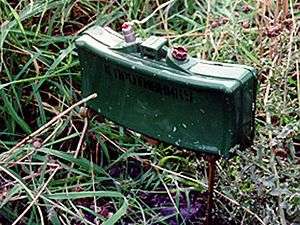MON-50



The MON-50 is a claymore shaped (rectangular, slightly concave), plastic bodied, directional type of anti-personnel mine designed and manufactured in the Soviet Union. It is designed to wound or kill by explosive fragmentation. The mine is similar to the American M18 Claymore with a few differences.[1]
Design
It has folding scissor type legs for supporting and aiming, but it also has an attachment point on the bottom for connecting a special clamp/spike which can be attached to wood, metal etc. It has a peep sight centered on the top which is flanked by two detonator cavities. The mine contains 700g of RDX (PVV-5A) to propel approximately 540 or 485 fragments to a lethal range of 50 meters in a 54° arc (spread of 45 meters at 50 meter range). The fragments can be steel balls (540) or short steel rods (485) depending on the variant.
The MON-50 is usually command actuated using a PN manual inductor and an EDP-R electric detonator. It can also be actuated by a variety of booby trap (BT) switches including the MUV series pull; the MVE-72 electric breakwire; or the VP13 seismic controller.
The MON 50 will usually be mounted above ground level on the surface or up in trees to give the greatest dispersion of fragments. It is waterproof and will function effectively from +50 to -50°C (it can be buried in snow as long as the pack in front of the mine doesn't exceed 10 cm, any more will greatly reduce the mine effectiveness).
The mine can be located visually or with metal detectors under most field conditions. Depending on its actuation method the MON-50 may be resistant to blast overpressure from explosive breaching systems like the Giant Viper and M58 MICLIC.
The MON-50 is currently manufactured in Russia and also manufactured for export in Bulgaria. The MON 50 is widely used in many parts of the world. It comes in a two pouch cloth bandolier which holds all the components for securing and command actuating the mine. It may also come packed in a VKPM-2 set which contains 4 mines complete with miscellaneous fuzes, control panel and wire.
Specifications
- Country of Origin: USSR
- Mine Action:
- Material: Plastic Casing
- Shape: Claymore
- Colour: Green, Grey, Olive
- Total Weight: 2 kg
- Explosive Content: 700 g of RDX (PVV-5A) explosive
- Length: 226 mm
- Width: 35 mm
- Height: 155 mm
- Fuse #1: Command detonated using PN manual inductor attached by demolition cable to an EDP-R electric detonator.
- Fuse #2: (one of the following)
- MUV Series Mechanical Pull
- MVE-72 Electric Breakwire (battery powered)
- VP13 Seismic Controller (battery powered)
Further information and effects
The mine has conventional or advanced seismic influence fuzing. It is a hand laid directional fragmentation mine which is normally command actuated (always secure command wires). The MON-50 is known to be used with the VP13 seismic controller which prevents close approach for any clearance operations, or to a variety of BT fuzes.
On detonation the mine will normally propel lethal fragmentation to a range between 40 and 60 meters, although the actual hazard range for these types of mines can be as high as 300 metres based on US Army tests of the M18A1 "Claymore" (this is directly in front of the mine, fragmentation range and density drop off to 125 meters to the sides and rear of these mines).
See also
Notes
- ↑ Brassey's Essential Guide to Anti-personnel Landmines, Eddie Banks, p.244